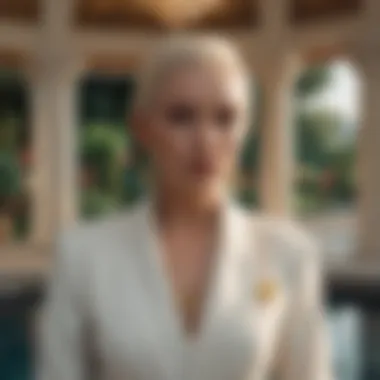Exploring 'The White Lotus' on HBO Max: A Comprehensive Examination


Intro
The cultural landscape of television has changed exponentially over recent years. HBO Max’s series, The White Lotus, emerges as a significant player in this shift, providing not just entertainment but an intricate commentary on social structures. As we explore this series, it is essential to consider the multiple themes woven throughout its narrative. These themes are complex, touching on privilege, identity, and human behavior, set against the backdrop of an idyllic resort.
Trending Topics
While viewing The White Lotus, one can’t help but notice certain thematic threads paralleling contemporary societal discussions.
Current Fashion Trends
The show's characters often display a range of fashion that reflects their personalities and social standing. The sartorial choices underscore their status, with wealthy guests adorned in designer attire, contrasting sharply with the more practical, subdued uniforms of the staff. This juxtaposition highlights themes of class and privilege — essential to the show's narrative. Viewers have pointed out that clothing is not just a matter of aesthetics; it serves as a visual cue to characters' emotional states and social hierarchies.
Beauty Innovations
Additionally, the portrayal of beauty standards is notable. The resort setting allows for an exaggerated demonstration of beauty practices. The characters often indulge in various wellness treatments, symbolizing their attempts to maintain a flawless exterior. Here, the series critiques not just the pursuit of beauty but also reflects on the insecurities and pressures women face in society.
Analysis of Character Development
Each character in The White Lotus offers a unique lens through which to explore social dynamics. From the haughty guest to the weary staff member, their stories intertwine, revealing deeper truths about human nature. Character arcs serve to reveal vulnerabilities, ambitions, and the masks people wear to navigate their lives.
Sociocultural Commentary
The series subtly critiques various sociocultural issues. Themes of wealth disparity and personal accountability emerge prominently throughout the plot. Dialogues and interactions often mirror real-world scenarios, allowing the audience to engage critically with the subject matter.
"The White Lotus not only entertains but also prompts viewers to reflect on their standards and the implications of privilege."
Synthesis
Preface to 'The White Lotus'
The introduction of 'The White Lotus' serves as a critical entry point into understanding the intricacies of this highly acclaimed series. By exploring the foundational aspects of the show, viewers can appreciate not only the surface-level plot but also the deeper thematic resonances that inform the narrative. This section will elucidate the series' backdrop and its cultural implications.
Overview of the Series
'The White Lotus' is a satirical television series created by Mike White. It debuted on HBO Max and quickly garnered attention for its sharp social commentary and unique storytelling approach. Set in a luxurious Hawaiian resort, the show follows the lives of affluent guests during their vacation. The narrative intricately weaves together the experiences of both guests and the hotel staff, offering a rich exploration of class dynamics and personal struggles.
The series comprises several seasons, each presenting new characters and narratives, but the core theme of privilege remains central throughout. By juxtaposing the lives of wealthy travelers with those of the resort employees, the show highlights the stark realities of socio-economic divides. The characters' arcs evolve, revealing their flaws and vulnerabilities, allowing audiences to engage with their journeys on a personal level.
Key Themes and Motifs
Several themes recur throughout 'The White Lotus', enriching its narrative. One of the most evident themes is privilege. The show critiques the carefree attitudes of the wealthy while exposing their inherent biases and flaws. As characters interact, their entitlement often becomes a focal point, leading to moments of discomfort and realization.
Another significant motif is human connection and isolation. Despite being surrounded by luxury, many characters grapple with feelings of disconnect and loneliness. Their interactions often reveal the fragility of relationships, underscoring a common human struggle that transcends class barriers.
Moreover, cultural critique arises as the series examines the tourist industry’s impact on local communities. Through careful character development and situational irony, the show invites viewers to reflect on their understanding of hospitality and exploitation. The portrayal of these motifs invites deeper inquiry into the characters' lives and broader societal implications.
"'The White Lotus' is not just a show about rich people vacationing. It offers a profound examination of what lies beneath the surface of wealth and leisure."
Overall, this introduction sets the stage for further exploration into the rich narratives and complex character dynamics presented in 'The White Lotus'. Understanding these foundational elements enhances the experience of viewing the series, enabling audiences to engage meaningfully with its content.


Setting and Cinematography
In 'The White Lotus', setting and cinematography are crucial to the storytelling. The series employs a stunning visual landscape to enhance its narrative. The luxurious, yet at times oppressive atmosphere of a tropical resort underscores the various themes of privilege and social dynamics. This duality is pivotal in making the show resonate. The location acts not just as a backdrop, but as a character in its own right, shaping the experiences of both guests and staff.
Location's Influence on Narrative
The location of a tropical resort in Hawaii serves as a rich tapestry against which the characters' lives unfold. The lush surroundings offer an illusion of paradise, which contrasts sharply with the unfolding drama. This setting reinforces the initial perception of wealth and happiness, while simultaneously laying bare the underlying tensions and issues.
Hawaii, known for its beauty, is also a site of historical contradictions. While it attracts the wealthy for relaxation, it also carries a complex legacy of colonialism and economic disparity. Characters like Armond and Rachel illustrate this tension. Their interactions are steeped in this backdrop, influencing decisions and relationships.
The resort also functions as a microcosm of society. The distinct, segregated spaces for guests and staff amplify the class disparities at play, exposing how privilege impacts human connections. In many scenes, the resort’s idyllic setting juxtaposes the characters' internal conflicts, heightening the drama.
Visual Aesthetics and Symbolism
The visual craftsmanship of 'The White Lotus' is evident in its cinematography. Each frame is thoughtfully composed to mirror the show's themes. Vibrant colors and expansive shots invite viewers into a dreamlike world, yet they also serve to highlight moments of discomfort and irony. The choice of angles and lighting adds depth to character interactions.
Symbolic elements are prevalent throughout the series. For instance, the ocean represents both escape and danger. It embodies the allure and peril that come with indulgence and privilege. Similarly, the use of natural light influences the mood. Bright, harsh light can reveal the raw truths behind character facades.
"The visual elements in 'The White Lotus' are not random; they are strategically used to enhance the narrative. Every shot speaks to the story's underlying messages."
Additionally, the production design, including luxurious decor and meticulous details, emphasizes the superficiality of the resort lifestyle. These aesthetics challenge viewers to look beyond the surface, prompting questions about authenticity and connection in a world defined by wealth.
Character Analysis
Character analysis in The White Lotus is essential to understanding the depth of the series. The creation and development of its characters are intricately woven into the narrative, reflecting wider social issues such as privilege, class disparity, and the complexities of human relationships. Each character serves as a lens through which audiences can scrutinize these themes, revealing the subtle and overt commentary threaded throughout the series.
Protagonists and Their Arcs
The protagonists in The White Lotus are multifaceted individuals, navigating their lives among the backdrop of indulgence and wealth. Figures like Rachel and Armond encapsulate divergent paths, influenced by their backgrounds and personal choices. Rachel is a young journalist adjusting to her new lifestyle, while Armond, the resort manager, embodies the struggle against the corporate machine, reflecting on work-life balance and personal fulfillment.
Their arcs provide insight into the ways one's environment alters personal development. For Rachel, her initial excitement transitions to disillusionment as she confronts the superficiality around her. This transformation sheds light on the often unseen barriers that define social categories. Armond’s journey, marked by his attempt to maintain dignity and connection with the guests, ultimately leads to tension, reflecting the often fragile balance between personal integrity and professional demands.
Supporting Characters: Depth and Complexity
Supporting characters in The White Lotus enrich the narrative significantly. Figures like Tanya and the two couples, Nicole and Mark, as well as Olivia and Quinn, each bring their unique perspectives. Tanya’s longing for connection showcases failings in her personal life, while Nicole and Mark depict the struggles of maintaining a marriage amidst changing social expectations. Olivia and Quinn offer another layer of complexity; Olivia’s entitlement often contrasts with her brother Quinn’s more authentic approach to life, reflecting generational divides.
Each supporting character contributes to the thematic richness by revealing contradictions in human behavior. Their development is crucial as they often act as catalysts for the protagonists’ growth, and their relational dynamics create a web of interaction that highlights individual motivations and social commentaries.
Character Relationships and Dynamics
Character relationships in The White Lotus are crucial in illustrating the show's societal critique. The dynamics between couples, as well as those between staff and guests, offer a microcosm of wider societal interactions. For instance, the relationship between Nicole and Mark stands as a representation of marital tensions exacerbated by external pressures, specifically showcasing themes of loyalty and betrayal.
Furthermore, the interactions between guests and staff, particularly between Armond and Rachel, emphasize the power struggles inherent in class differences. These relationships expose the underlying resentment and desires that shape human interactions, ultimately presenting an intricate portrayal of social standings.
"Character dynamics in The White Lotus intricately explore the conflict between desires and reality, exposing the delicate balance of social hierarchies."
In summary, character analysis in The White Lotus is not merely observational but serves as a vital aspect of the storytelling. It invites viewers to reflect on their own perspectives concerning privilege, connection, and individuality within a collective society.
Thematic Exploration
The thematic exploration within 'The White Lotus' is crucial to understanding its layered storytelling. By dissecting the themes presented, viewers gain insights into the series’ critique of modern society and its values. The exploration of themes not only illuminates the characters’ intentions but also provides commentary on the cultural and social fabric of our world. This section aids in uncovering the subtleties that often go unnoticed, emphasizing elements that resonate with real life.


Privilege and Class Disparities
'The White Lotus' deftly exposes privilege and class disparities through its portrayal of wealthy vacationers and resort staff. Characters like Mark and Nicole Moss embody a sense of entitlement often exacerbated by their socioeconomic status. They vacillate between vulnerability and arrogance, highlighting how wealth shapes their interactions and decisions.
The stark contrast between guests and employees establishes a microcosm of societal divides. Staff members, such as Paula and Armond, navigate their roles with varied moral compasses, revealing the complexity of survival within their lower status. This disparity is not just a backdrop but a critical narrative device that drives the plot. The series invites viewers to reflect on the implications of wealth, influence, and their effects on human relationships.
"Privilege can blind individuals to the reality of others' struggles."
The examination of these aspects may lead to broader discussions on equality and understanding in today’s society.
Human Connection and Isolation
Another theme prevalent in 'The White Lotus' is the paradox of human connection and isolation. Characters often find themselves surrounded by others yet remain emotionally distant. For instance, Tanya's loneliness amid her lavish lifestyle illustrates that wealth does not equate to fulfillment. Similarly, the resort’s setting, designed for relaxation, serves as a backdrop for personal conflicts and unresolved issues.
This theme complicates traditional notions of togetherness. Rather than fostering connection, the interactions often reveal emotional isolation. Viewers are encouraged to consider how modern life can create barriers to authentic connection. The repetitive motifs of guests seeking solace while grappling with feelings of emptiness resonate deeply with the audience's collective experiences, causing them to reevaluate their own connections.
Cultural Critique and Commentary
Through its narrative, 'The White Lotus' offers cultural critique and commentary on contemporary societal norms. The series provides a lens through which to explore not only the opulence of luxury travel but also the ethical dilemmas tied to it. Characters display varying degrees of self-awareness and reflection about their roles within the resort’s framework.
The show tackles topics such as environmental exploitation, the superficiality of social media personas, and the often hidden costs of privilege. With sharp dialogue and complex character arcs, it critiques the disconnection in modern consumerism. By addressing these issues, 'The White Lotus' engages the audience in discussions that extend beyond the screen, challenging viewers to rethink their own societal roles.
In summary, each thematic aspect from privilege and class disparities to cultural critique adds depth to 'The White Lotus'. This examination paves the way for greater understanding, prompting audiences to engage not only with the series but with the world around them.
Narrative Structure
The narrative structure of The White Lotus is critical to understanding its themes and character dynamics. A well-crafted narrative allows for exploration of complex ideas, sometimes layered beneath the surface. In this series, the structure consists of episodic formatting, which provides a framework that allows the story to unfold gradually, revealing the intricacies of each characters’ motivations and backgrounds. This structure is not merely for storytelling; it serves to evoke emotion and engage the viewer on multiple levels.
Another important factor is pacing, which dictates the rhythm of the series. Effective pacing ensures that the audience remains invested in the characters' journeys while also allowing for the tension to build steadily until climactic moments. The careful balance of time allocated to exposition versus action can create a deeper sense of attachment to the unfolding drama. Thus, both episodic formatting and pacing play a pivotal role in shaping the narrative experience, making it not just a story, but a profound discussion about privilege, human connection, and personal growth.
Episodic Formatting and Pacing
Episodic formatting in The White Lotus is essential for constructing its ongoing drama. Each episode stands as a distinct unit while contributing to the larger narrative arc. This structure allows each character to have moments of exploration without overwhelming the viewer with too much information at once. We see characters developing over time, such as Rachel's growing disillusionment with her surroundings and the interpersonal conflicts that arise within the resort.
The pacing of the episodes also prioritizes character depth over rapid plot advancement. This approach gives viewers the chance to pause and reflect. Characters are rarely defined by single moments; their complexity shines through small interactions and evolving relationships. By doing this, the series crafts a powerful commentary on how privilege can distort human connections.
Climactic Tension and Resolutions
Climactic tension in The White Lotus often hinges on the build-up of interpersonal conflicts that tease the audience’s expectations. As each character's story unfolds, the narrative maintains a level of suspense that keeps viewers guessing. For example, the tension between the guests and the resort staff escalates, creating an atmosphere thick with anticipation.
The show's climax is not always explosive; sometimes it reflects quieter, more introspective resolutions. The series avoids neat conclusions, opting instead for an exploration of the characters' emotional landscapes. This technique showcases the fallout of their actions and the realities they must confront. Each resolution acts as a commentary on the complexities of human behavior, ultimately leaving viewers pondering the lasting implications.
"Narrative structure is not just the backbone of the visual experience; it embodies the themes and character explorations integral to the viewer's connection with the story."
Through its meticulous approach to episodic storytelling and pacing, along with artfully constructed climactic moments, The White Lotus offers a multifaceted view of privilege and human experience. This detailed examination ultimately invites a comprehensive understanding of the narrative, setting it apart as a noteworthy series in contemporary television.
Audience Reception and Impact
Audience reception and impact are critical aspects of understanding any television series, especially one that delves into complex themes like privilege and social dynamics, such as The White Lotus. The way viewers respond can reflect not only the series' artistic merit but also its cultural relevance and the conversations it sparks among audiences. This section will highlight the various dimensions through which the reception of the series can be analyzed, including the critical acclaim it has received and the discourse it has generated among viewers.


Critical Acclaim and Awards
The White Lotus has garnered significant recognition from critics and various award bodies. Its commentary on class disparity, coupled with sharp writing and outstanding performances, has captivated a wide audience. The series has won multiple awards, including several Emmy Awards, showcasing its impact in the industry. Critics praise the layered storytelling and the depth of character development, noting how each character's flaws and motives contribute to the overarching narrative of privilege and disconnection.
The acclaim is not just limited to major awards. Critical consensus on platforms such as Rotten Tomatoes and Metacritic shows a favorable reception, underscoring its significance in contemporary television. For example, the writing, direction, and acting have consistently received high marks. Critics often emphasize how the series challenges norms and invites viewers to reflect on their own societal positions.
Viewer Discourse and Analysis
Viewers have engaged deeply with The White Lotus, sparking extensive discussion across platforms like Reddit and social media. Many fans dissect character arcs and moral dilemmas, revealing personal interpretations that resonate with their own experiences. This kind of discourse highlights the series' ability to reflect societal realities, further enhancing its cultural footprint.
The conversations surrounding the show often focus on its satirical elements, addressing both the humor and the poignant critique of affluence. Fans have shared insights into the symbolism within various scenes and how these elements tie back to the themes of human connection and isolation. In many cases, viewers identify with characters, scrutinizing their motivations and ethical decisions, which fosters a community of dialogue that enriches their viewing experience.
“The White Lotus is more than entertainment; it’s a mirror reflecting our societal flaws and prompting critical conversations.”
The discussions surrounding The White Lotus create a vibrant exploration of class and personal identity in modern society. The show has undoubtedly left a mark on how narratives are crafted in contemporary television.
In summary, audience reception and impact are crucial for interpreting the relevance of The White Lotus. Its critical acclaim and viewer discourse illuminate both its thematic depth and its cultural significance, creating pathways for deeper understanding and engagement.
The Soundscape of 'The White Lotus'
The soundscape in 'The White Lotus' plays a critical role in shaping the viewer's experience. Sound goes beyond the visual representation; it sets the emotional tone and affects how audiences interpret the characters and their actions. Understanding this dimension leads to a deeper appreciation of the series and its thematic complexities. It heightens tension in dramatic moments and contrasts the underlying themes of privilege and isolation.
Musical Composition and Themes
The musical composition in 'The White Lotus' is meticulously crafted to complement the series' overall narrative. The score often reflects the luxurious yet superficial setting of the resort. Michael Imperioli's choice of music is both eclectic and sultry, providing a backdrop that enhances the viewer's immersion in the story. The use of haunting melodies and rhythmic patterns adds layers to character interactions, often foreshadowing impending conflict or revelation.
Prominent themes emerge through the music. For instance, recurring motifs align with specific characters, helping the audience connect with their emotional journeys. This makes the music not just background noise but a significant player in storytelling.
Sound Design and Mood
Sound design contributes significantly to the atmosphere in 'The White Lotus.' The soundscape captures the ambiance of the resort, emphasizing both the beauty and the emptiness that can coexist in such idyllic settings. Ambient sounds, like waves crashing or birds chirping, serve to soothe yet can also evoke a sense of discomfort, hinting at the underlying tensions relating to class and status.
Scenes featuring dialogue are often layered with natural sounds, creating a more immersive experience. This allows viewers to feel as if they are part of the interactions. The subtleties in the sound design illustrate characters' emotions and relationships effectively.
"In 'The White Lotus', sound transforms moments, making the viewer feel the weight of privilege and isolation without the need for dialogue."
Ultimately, the soundscape in 'The White Lotus' perfectly aligns with its themes. It enriches the storytelling, making the audience reflect not just on actions, but on the motivations and emotions of the characters involved.
The End: The Legacy of 'The White Lotus'
The conclusion serves as a critical junction in understanding the overall impact of 'The White Lotus' on contemporary television. This series carved out a unique place in the cultural landscape, prompting viewers to reflect on their own perceptions of privilege, class, and interpersonal relationships. Notably, it does not merely entertain but engages in profound dialogues that resonate well beyond its runtime.
Lasting Effects on Television
'The White Lotus' signifies a shift in how complex narratives are portrayed in series format. The interplay between the guests and the staff offers a multifaceted look at class disparities and privilege. Many shows have tackled similar themes; however, this series blends humor with social critique, maintaining a balance that both captivates and provokes thought.
- This approach encourages a deeper analysis among viewers.
- The series invites discussions about the ethical implications of wealth and social structures.
- Viewers now expect more nuanced storytelling in future shows.
"A poignant critique, set against a luxurious backdrop, that invites viewers to confront uncomfortable truths about society."
Implications for Future Storytelling
The legacy of 'The White Lotus' extends into the evolution of television narratives. Its innovative storytelling and character development have paved the way for future productions. This series demonstrates that audiences are not only willing but eager to engage with content that challenges societal norms.
- Future writers may take inspiration from the series by intertwining humor and drama while addressing complex subjects.
- The character arcs observed prompt a re-evaluation of how supporting characters are portrayed, emphasizing depth and complexity.
- It sets a new benchmark for critiques of societal structures, influencing emerging series and their creators.
As we move ahead, the influence of 'The White Lotus' may continue to echo through various genres, urging creators to explore the topics of privilege and connection with more diligence. The proactive engagement of the audience creates a fertile environment for storytelling that is both rich and relevant.



